New Age travellers
Topic: Unsolved
 From HandWiki - Reading time: 5 min
From HandWiki - Reading time: 5 min
 Vehicles used by New Age travellers | |
| Regions with significant populations | |
|---|---|
| United Kingdom | |
| Religions | |
| New Age |
New Age Travellers (synonymous with and otherwise known as New Travellers[1]) are people located primarily in the United Kingdom generally espousing New Age beliefs with hippie or Bohemian culture of the 1960s. New Age Travellers used to travel between free music festivals and fairs prior to crackdown in the 1990s. New Traveller also refers to those who are not traditionally of an ethnic nomadic group but who have chosen to pursue a nomadic lifestyle.[2]
There are a variety of New Traveller subcultures which include New Nomads[3] and Digital Nomads[4] facilitated by the digital age, globalisation and worldwide travel.
A New Traveller's transport and home may consist of living in a van, vardo, lorry, bus, car or caravan converted into a mobile home while also making use of an improvised bender tent, tipi or yurt. Some New Travellers and New Nomads may stay in guest bedrooms of hosts, or pay for inexpensive affordable lodgings while living in different locations around the world as part of their New Traveller lifestyle.
"New Age" travellers largely originated in 1980s and early 1990s Britain,[5] when they were briefly known pejoratively as crusties because of the association with "encrusted dirt, dirt as a deliberate embrace of grotesquerie, a statement of resistance against society, proof of nomadic hardship."[6] However, New Travellers can come from all walks of life and socio-economic backgrounds.
History
Origins
The movement originated in the free festivals of the 1960s and 1970s[7] such as the Windsor Free Festival, the early Glastonbury Festivals, Elephant Fayres, and the huge Stonehenge Free Festivals in Great Britain. However, there were longstanding precedents for travelling cultures in Great Britain, including travelling pilgrims, itinerant journeymen and traders, as well as Irish Travellers, Romani groups and others.[8]
Peace convoy
In the UK during the 1980s the travellers' mobile homes—generally old vans, trucks and buses (including double-deckers)—moved in convoys. One group of travellers came to be known as the Peace Convoy after visits to Peace camps associated with the Campaign for Nuclear Disarmament (CND).[7] The movement had faced significant opposition from the British government and from mainstream media, epitomised by the authorities' attempts to prevent the Stonehenge Free Festival, and the resultant Battle of the Beanfield in 1985—resulting in what was, according to The Guardian , one of the largest mass arrests of civilians since at least the Second World War,[9] possibly one of the biggest in English legal history.[10]
References
- ↑ Frediani, Marcelo (18 December 2017). "On the road: New Travellers and their radical need for space". Espaces et Sociétés 171 (4): 73–89. doi:10.3917/esp.171.0073. https://www.cairn-int.info/article-E_ESP_171_0073--on-the-road-new-travellers-and-their.htm.
- ↑ "Example Definitions of Gypsies and Travellers in the UK". https://www.gov.scot/publications/local-development-plans-defining-gypsies-travellers-consultation/pages/6/.
- ↑ Marquardt, Felix (2021) (in English). The New Nomads (1st ed.). UK: Simon&Schuster. ISBN 9781471177378.
- ↑ Bearne, Suzanne (2023-11-04). "Digital nomads: rising number of people choose to work remotely" (in en-GB). The Guardian. ISSN 0261-3077. https://www.theguardian.com/money/2023/nov/04/digital-nomads-work-remotely-tech-visas.
- ↑ "New Age Travellers - a traveller lifestyle and subculture in Britain". http://subcultureslist.com/new-age-travellers/.
- ↑ Fox, Dan (3 April 2018). "24-Hour Party People: How Britain's New Age Traveler movement defined a zeitgeist" (in en). World Policy Journal 35 (1): 3–9. doi:10.1215/07402775-6894684. ISSN 1936-0924. https://muse.jhu.edu/article/689308/summary.
- ↑ 7.0 7.1 "New Travellers, Old Story". The Children's Society. http://www.childrenssociety.org.uk/sites/default/files/tcs/research_docs/Heritage%20pack_v5.pdf.
- ↑ Ivakhiv, Adrian (2001). Claiming Sacred Ground: Pilgrims and Politics at Glastonbury and Sedona. Indiana University Press. p. 89. ISBN 0-253-33899-9. https://books.google.com/books?id=QNHTOvnZ3poC&q=romany+%22peace+convoy%22&pg=PA89.
- ↑ "What happened next?" (in en). 2004-02-22. http://www.theguardian.com/theobserver/2004/feb/22/features.magazine27.
- ↑ Stuart Maconie (2014). The People's Songs: The Story of Modern Britain in 50 Records. Ebury Press. pp. 356–. ISBN 978-0-09-193380-7. https://books.google.com/books?id=_q4rAwAAQBAJ&pg=PA356.
Further reading and external links
- O'Brien, Mark and Ashford, Chris. "'Tribal Groups' in Modern Britain: Legal Theory, Legal Practice and Human Rights" [2002/3] Contemporary Issues in Law Vol 6, Issue 2 180-206
- Gardner, Peter. "Medieval Brigands, Pictures in a Year of the Hippy Convoy" Published 1987 by Redcliffe, Bristol. ISBN:0-948265-02-7
- Colville, Fergus. Timeshift: New Age Travellers BBC Four, August 2005
- Lodge Alan, A gallery of New Age Traveller images, mostly from the 80s and 90s Retrieved 2008-11-04
- Sharkey's Busbarn, Gypsy Faire "Many of these images [from New Zealand] come courtesy of Chris Fay, previous editor and publisher of Roadhome NZ, a now-ceased publication for road folk."
- Staff, BBC 2003, Inside Out, BBC, 20 January 2003, "After being forced to camp illegally for years, Brighton Council are the first to introduce a legal site for New Age Travellers".
- Worthington, Andy (Jun 2005) The Battle of the Beanfield, Enabler Publications and Training Services, ISBN:0-9523316-6-7, ISBN:978-0-9523316-6-7
- Worthington, Andy (June 2004). Stonehenge: Celebration and Subversion, Alternative Albion, ISBN:1-872883-76-1, ISBN:978-1-872883-76-2
- UK Hippy [1] and Tribal Living [2] counter-culture community websites.
- A Different Light Youthful travelers in contemporary America: An interview
- Zwissler, Laurel (2011). "Pagan Pilgrimage: New Religious Movements Research on Sacred Travel within Pagan and New Age Communities". Religion Compass (Wiley) 5 (7): 326–342. doi:10.1111/j.1749-8171.2011.00282.x. ISSN 1749-8171. https://www.academia.edu/34541493.
 |
 KSF
KSF